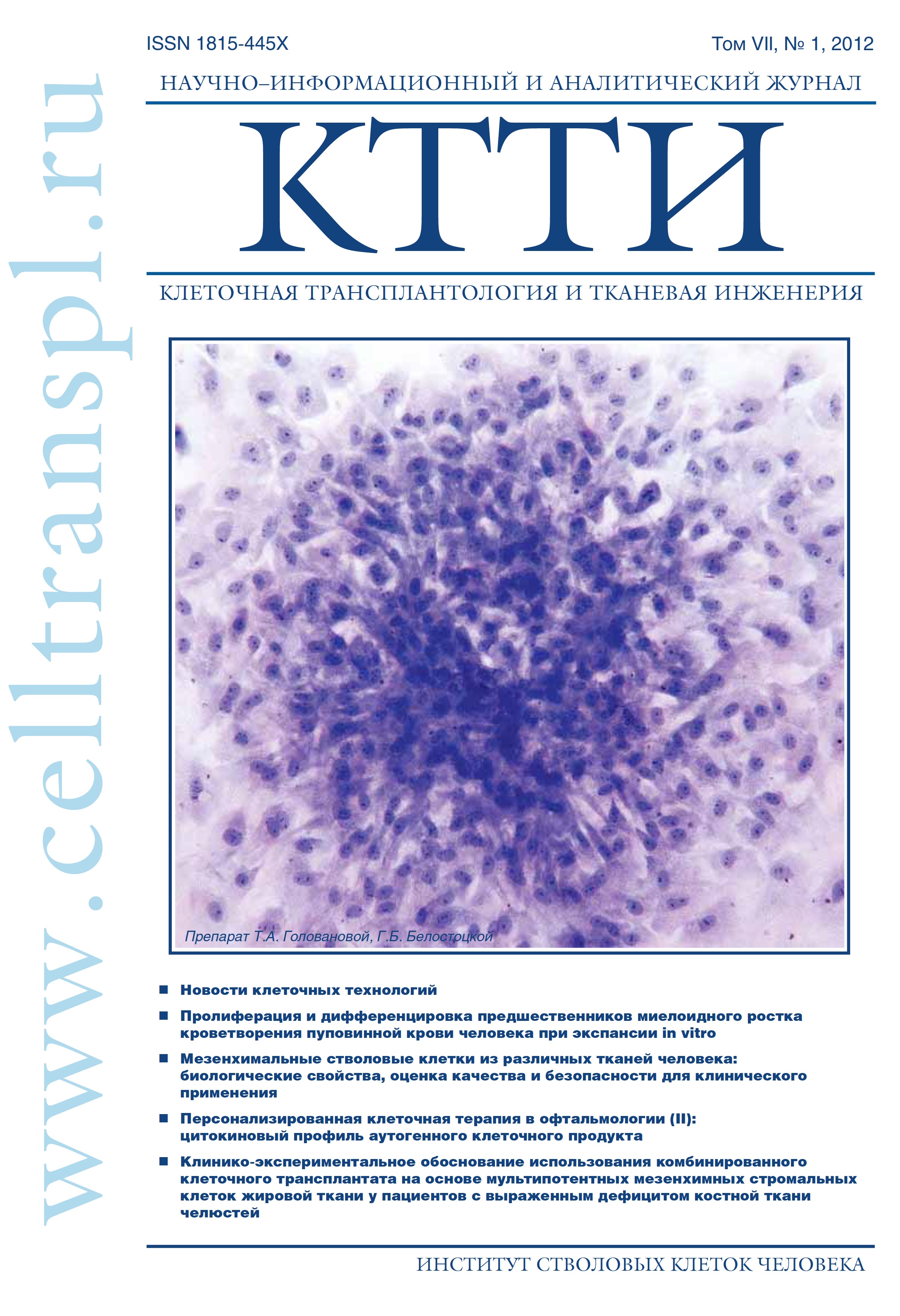From organ transplantation to reparative spheroids and «microtissues» in suspension 3D-culture
- Authors: Repin VS1, Saburina IN1
-
Affiliations:
- Institute of General Pathology and Pathophysiology RAMS, Moscow
- Issue: Vol 7, No 1 (2012)
- Pages: 106-108
- Section: Articles
- Submitted: 11.01.2023
- Published: 15.03.2012
- URL: https://genescells.ru/2313-1829/article/view/121706
- DOI: https://doi.org/10.23868/gc121706
- ID: 121706
Cite item
Abstract
4 experimental alternatives has been developed for
organ transplantation: 1. Cell therapy as a suspension of
disorganized somatic and stem cells. 2. The Grafts of well
differentiated cells on 3D-matrix to compensate (restore)
the damaged function. 3. Translational medicine - single
selected pilot project of personalized medicine of auto- stem
cell sphere transplantation with a new emergent potential for
tissue morphogenesis and regeneration. 4. High throughput
cellular serial fabrics for multiple generation of standard
micro-tissues and 3D-mini-tissues. They are especially
devoted to this essay.
organ transplantation: 1. Cell therapy as a suspension of
disorganized somatic and stem cells. 2. The Grafts of well
differentiated cells on 3D-matrix to compensate (restore)
the damaged function. 3. Translational medicine - single
selected pilot project of personalized medicine of auto- stem
cell sphere transplantation with a new emergent potential for
tissue morphogenesis and regeneration. 4. High throughput
cellular serial fabrics for multiple generation of standard
micro-tissues and 3D-mini-tissues. They are especially
devoted to this essay.
About the authors
V S Repin
Institute of General Pathology and Pathophysiology RAMS, MoscowInstitute of General Pathology and Pathophysiology RAMS, Moscow
I N Saburina
Institute of General Pathology and Pathophysiology RAMS, MoscowInstitute of General Pathology and Pathophysiology RAMS, Moscow
References
- Genuis S.J. Medical practice and community health care in the 21 century: a time of change. Public. Health. 2008; 122: 671-80.
- Brenner S. Editorial: humanity as the model system. Science 2003; 302: 533
- Perpich J.G. The dawn of genomic and regenerative medicine: new paradigm for medicine, the public health and society. Technol. in Society. 2004; 26: 405-14
- Rivron N.C., Rouwkewa J., Truckenmuller R. et al. Tissue assembly and organization: developmental mechanisms in microfabricated tissues. Biomaterials 2009; 30: 4851-8.
- Mironov V., Visconti R.R., Kasjanov V. et al. Organ printing: tissue spheroids as a building blocks. Biomaterials 2009; 30: 2164-74.
- Koch T.G., Berg L.C., Betts D.H. et al. Current and Future Regenerative Medicine. Can. Vet. J. 2009; 50: 155-65.
- Cohen I.R., Harel D. Explaining a complex living system: dynamics, multiscaling and emergence. J. R. Soc. Interface. 2007; 4: 175-82
- Milotti E., Chignola R. Emergent properties of tumor microenvironment in a real life model of multicellular tumor spheroids. PlosONE 2010; 5: e3942-e52.
- Wolkenhauer O., Shibata D.K., Mesarovich M. A stem cell niche microdominance theorem. BMC System Biol. 2011; 54: 1-16.
- Khademhosseini A., Langer R., Borenstein J. et al. Microscale technologies for tissue engineering and biology. PNAS USА 2006; 103: 2480-7.
- Sakamoto K., Nakahara T., Ishii T. Rho-Rho kinase are involved in the protective effect of of early ischemic preconditioning in the rat heart. Biol. Pharm. Bull. 2011; 34: 156-9.
- Zhang L., Valdez J.M., Zhang B. et al. ROCK inhibitor Y-27632 suppresses dissociation-induced apoptosis of murine prostate stem/ progenitor cells and increases their cloning efficiency. PlosONE 2011; 6: e18271-e81.
- Сhayosumrit M., Tuch B., Sidhu K. et al. Alginate microcapsules for propagation and directed differentiation of hESCs to definive endoderm. Biomaterials 2010; 31: 505-19.
- Ruiz S.A., Chen C.S. Emergence of patterned stem cell differentiation within multicellular structures. Stem Cells 2008; 26: 2921-7.
- Lund A.W., Yener B., Stegeman J.P. et al. The natural and engineered 3D microenvironment as a regulatory cue during stem cell fatr determination. Tissue Eng. 2009; 15: 371-80.
- Nelson T.I., Behfar A., Terzic A. Strategies for therapeutic repair: The 6 R regenerative medicine paradigm. CTS 2008; 1: issue 2: 168-88.
- Sedivy J.M., Banumathy G., Adams P.D. Aging by epigenetics - a consequence of chromatin damage? Exp. Cell Res. 2008; 314: 1909-17.
- Sinclair D., Oberdoerffer P. The aging epigenome: damage beyond repair? Aeing. Res. Rev. 2009; 8: 189-98.
- Fraga M.F. Genetic and epigenetic regulation of aging. Curr. Opin. Imuunol. 2009; 21: 446-53.
- Turchinsky A.L., Turner B., Borja R.C. DAnCER: disease annotated chromatin epigenetics. Nucleic Acid Res. 2011; 39: D789-98.
- Ernst J., Kellis M. Discovery and characterization of chromatin states for systemic annotation of the human genome. Nature Biotechnol. 2010; 28: 817-30.
- Collino F., Deregibus M.C., Bruno S. Microvesicles derived from adult human bone marrow and tissue specific MSCs shuttle selected patterns of micro-RNAs. PlosONE 2010; 5: e11803-e13
- Naylor S., Chen J.Y. Unraveling human complexity and disease with system biology and personalized medicine. Per. Med. 2010; 7: 275-89.
- Hime G.R., Samers W.G. Micro-RNA-mediayed regulation of proliferation, self-renewal and differentiaton of mammalian stem cells. Cell Adhes. Migrat. 2009; 3: 425-32.
- Shalgi R., Lieber D., Oran M. et al. Global and local architecture of the mammalianmicro-RNAs - transcriptional factor regulation network. PloS Comput. Biol. 2007; 3: e1310-e41.
- Li J., Liu Y., Kim T. et al. Gene expression variability within and between human populatons and implications toward disease susceptibility. Plos. Comput. Biol. 2010; 6: e1000910-e945
- Kuhn D.E., Nuovo G.J., Terry A.V. et al. Chromosome-2`1- derived micro-RNAs provide an ethiological basis for aberrant protein expression in human Dawn syndrome brain. J. Biol. Chem. 2010; 285: 1529-43.
Supplementary files










